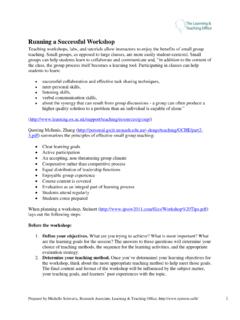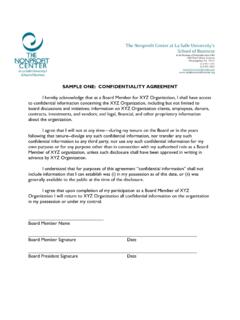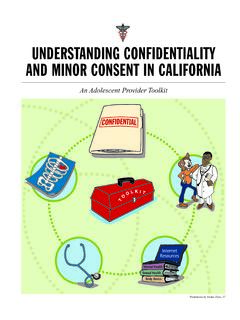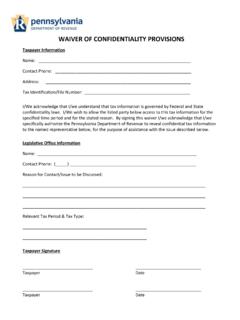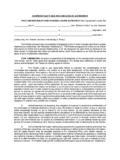Transcription of Guidelines on Anonymity and Confidentiality in Research
1 Guidelines ON Anonymity AND Confidentiality IN Research Development Date: May 2015 Revised Date: November 2017 Guidelines on Anonymity and Confidentiality in Research 2 Table of Contents 1. Purpose .. 3 2. Background and Key 3 3. Managing Confidentiality .. 4 4. The Limits of Privacy and Confidentiality : Special Circumstances .. 5 I. Research Inimical to Protecting the Confidentiality of Participants Information .. 5 II. Legal Necessity & Duty to Report .. 6 III. Respecting the Autonomy of Research Participants .. 6 5. Confidentiality Breach .. 7 Development Date: May 2015 Revised Date: November 2017 Guidelines on Anonymity and Confidentiality in Research 3 1.
2 PurposeThe purpose of this guideline is to provide researchers with information on Anonymity and Confidentiality with respect to Research involving human participants. It also lays out three special circumstances where there may be limits to respecting the privacy and Confidentiality of Research participants. 2. Background and Key TermsAll researchers conducting studies involving humans have a duty to protect the privacy of their participants. This entails that researchers take steps to properly safeguard sensitive and personal information that participants would not reasonably want to disclose to others or make public. There are two main ways to ensure that the privacy of participants is being respected: (1) by conducting anonymous Research , and (2) by conducting confidential Research means that at no time will the researcher or anyone associated with the project know the identity of the participants.
3 In anonymous Research , the information collected does not contain any identifiable information, and the risk of being able to attribute data to particular individuals is low (p. 59). *i Confidential Research means that proper safeguards are in place to protect the privacy of participants and their information from unauthorized access, use, disclosure, modification, loss, and theft (p. 202). Anonymized Information is information that is irrevocably stripped of all direct identifiers , name, social insurance number, health number, etc., and where both the risk of re-identification from remaining indirect identifiers is low, and where no codes exist that couldallow for future re-linkage (p.)
4 206). When information is anonymized, even the researcher willnot be able to link data to Data is data provided to the researcher in de-identified form and the existing key code is accessible only to a custodian or trusted third party who is independent of the researcher ( ). Identifiable information is information that may reasonably be expected to identify an individual alone or in combination with other available information (p. 205). This includes both direct and indirect identifying information. Direct identifying information identifies a specific individual through identifiers, such as a name, social insurance number, personal health number, etc. Indirect Identifying information is information that can reasonably be expected to identify an individual through a combination of indirect identifiers, such as someone s date of birth, place of residence, unique characteristics, and so on (p.
5 206). Development Date: May 2015 Revised Date: November 2017 Guidelines on Anonymity and Confidentiality in Research 4 Coded Information is information that has been stripped of all direct identifiers and replaced with a code. This code can then be used to attribute specific data to particular participants (p. 206). 3. Managing ConfidentialityAll individuals conducting Research involving human participants have a duty to keep their participants information confidential ( ). This duty entails that researchers implement safeguards to protect the Confidentiality of their participants throughout all stages of the Research cycle. This includes the following stages: Recruitment; The initial collection of information/data; The use of and analysis of the information/data collected; The dissemination of the findings; The storage and retention of information; and The disposal of records or devices on which information is how researchers should go about incorporating safeguards at these various stages of the Research cycle will vary based on the nature of their projects.
6 Below are f types of safeguards that may be put into place in order to help protect the Confidentiality and privacy of Research participants: physical safeguards, administrative safeguards, technical safeguards, and Research design safeguards. safeguards are measures that secure the location of private and sensitiveinformation from unauthorized personnel. Examples of physical safeguards include locked filingcabinets, secluded interview rooms, private offices, storing information away from public, andeasily accessible areas, etc. (p. 63). safeguards are measures that protect the privacy of participants informationby clearly delineating who does and who does not have access to participants information, andin what ways (p.)
7 63). Typically, the greater the number of individuals that have access to privateand confidential information, the more difficult it is to protect the privacy and Confidentiality ofparticipants information. As a result, a minimum number of Research staff, all of whom must beinstructed about Confidentiality requirements, should have access to participants safeguards are technological measures that protect the privacy of include the use of computer passwords, firewalls, anti-virus software, encryption andother measures that protect data from unauthorized individuals, loss, theft or modification ( Date: May 2015 Revised Date: November 2017 Guidelines on Anonymity and Confidentiality in Research 5 63).
8 Typically, all electronic data should be password protected, and based on the sensitivity of the information, also encrypted. design safeguards are measures intrinsic to the Research design of a project thathelp protect the privacy of Research participants. These include: anonymizing information,transcribing raw data as soon as possible, storing de-identified data separately from codinglists, shredding all hard copies with sensitive information as soon as feasible, and so is important to note that the onus is on researchers to demonstrate to the Research Ethics Board (REB) that the Confidentiality of Research participants is being adequately safeguarded and protected.
9 The safeguards implemented by researchers to protect the privacy and Confidentiality of Research participants should be clearly stated in the section entitled Privacy and Confidentiality in the online application and on the consent form. 4. The Limits of Privacy and Confidentiality : Special CircumstancesThere are three circumstances where the duty to protect the privacy and Confidentiality of participants information may be outweighed by other competing factors: (I) where adopting measures to protect the privacy of participants is inimical to the integrity of the Research design; (II) where researchers are under a legal responsibility or a duty to report participants information to the authorities; and (III) where respecting the Confidentiality of participants information undermines the autonomy of Research participants.
10 Inimical to Protecting the Confidentiality of Participants InformationResearchers whose projects are inimical to protecting the Confidentiality of participants information such as large focus groups may be unable to ensure that their participants information is kept confidential. In cases such as this, the researcher must disclose the privacy and Confidentiality risks to potential participants inherent in their participation to the REB, and to participants in the consent form, and, if possible, also in person. For example, in the case of a focus group, a researcher should write something like the following on the consent form: While I, the researcher, will respect the Confidentiality of all participant s information, I cannot promise or ensure that other participants will do the same.





